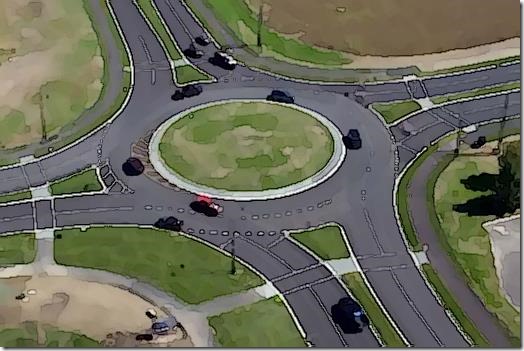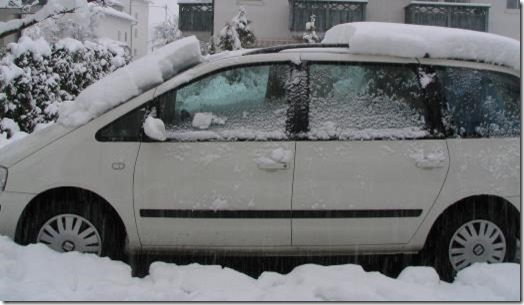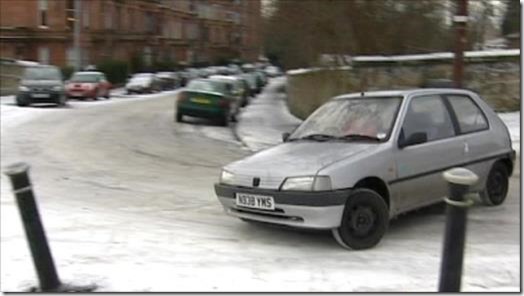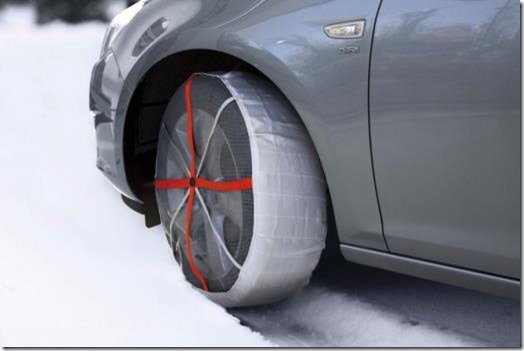DVSA has been putting out reminders about the Highway Code and how it relates to driving in bad weather. Quite right, too.
Snow On The Roof
Anyone who drives their car with a thick cover of snow on the roof doesn’t deserve to hold a driving licence. Furthermore, if the idiot in question has kids with them then they are in need of an urgent visit from Social Services to discuss suitable foster homes for the protection of their offspring.
Look at the picture below, which shows how a covering of snow on the roof can suddenly slip and obscure the driver’s view (and this appears to be on a stationary vehicle).
It is not a rare occurrence – it happens more times than it doesn’t in this country, I can assure you. I witnessed it happen to several moving cars while out on lessons over the weekend, but the “best” one was on Sunday.
I’d just dropped a pupil off after a lesson, and on approaching the Crown Island to join the busy ring road I’d already had to negotiate a taxi which was stopped at a set of lights with its hazard lights on (I assume it had broken down, though with taxis it’s hard to tell, and having one of them stop in the middle of a box junction at a crossroads to pick up a fare isn’t as unlikely an event as you might think). Anyway, as I approached the island there was another major hold up. This time some prat had stopped in the right hand approach lane about two car lengths from the give way line. Why? Because he’d got a 3” deep slab of snow on the roof, had braked hard, and the snow had fallen down as a frozen sheet on to his windscreen. It was too heavy for the wipers to clear, so the dolt had had to get out and start shovelling by hand.
He was lucky he hadn’t driven into the back of someone. He was lucky no one had driven into the back of him. He was lucky his wipers hadn’t snapped or burnt out when he vainly tried to wipe the ice clear. And he was lucky he hadn’t discharged his battery. Mind you, come to think of it, any of those last three things could still have happened for all I knew after I’d got past him.
He should have cleared his roof before he left home, of course. But that would have meant dumping the nasty snow in his own driveway instead of on the approach to a roundabout where it could cause significant danger to other drivers. These prats who think it’s really clever to keep snow on the roof – either to amuse the kids, or themselves – inevitably lose it at some stage. Even if it doesn’t fall on to their windscreen it ends up all over the road when they brake sharply, which this kind of person is wont to do at every junction and roundabout. Eventually, there is just the right combination of melting underneath and freezing on top to send the sheet hilariously on to the road where a previously clear road now has an ice patch right where you least want one.
Steamed-up Windows
Then there’s the problem of steamed up car windows. I’m sick of being cut up by cars full of spotty-faced kids with windows completely steamed up. These people can’t drive very well at the best of times, so you’d imagine that they’d want to have a good all-round view, wouldn’t you? Apparently not, though, and they’d much rather just fling the car from lane to lane without having a clue who or what is behind them.
I took a young lad out on a Pass Plus session the other day. He wasn’t one of my own ex-pupils, and he had lots of questions. One of them was:
Is it normal for cars to steam up like this all the time?
We’d been driving for a few minutes and the side windows had started to mist up. I explained to him that yes, unfortunately it was normal. It happens because the cold air cannot hold the moisture that the passengers are giving off, so it condenses out on to cold surfaces. I then gave him my “show me, tell me” question talk, explaining that there are three main ways to clear mist off the windows:
- The Heated Window button(s) – to demist the back, push the button that turns on the heated rear window. Some cars have a heated front windscreen, too, which has a similar effect at the front.
- The Heater/Fan – by blowing a lot of warm air at the windscreen and side windows, the mist is evaporated.
- The Air-conditioning – the aircon system dehumidifies the air, which completely prevents misting up to start with, and eliminates it quickly if it’s already happened. It uses a little more fuel at lower speeds – and I said “a little”.
He was amazed at how the aircon sorted out the problem within a minute. What’s more, after I switched it off the car remained mist-free for the whole 2 hour session. But I am fairly certain that a lot of drivers out there don’t even know about the heated rear window, let alone whether or not their car has a heated front window or air-conditioning.
Note that you can get demister sponges – made from chamois or faux-chamois wrapped around a foam pad – which work well up to a point. They’re ideal for cars which don’t have aircon. What puts me off them is that after you’ve used them a couple of times they pick up grease and leave smears on the glass.
Inappropriate Speed
On Monday this week I was sitting with a pupil outside his house at the start of a lesson. His roads were all covered in shiny sheet-ice as a result of compacted snow and no gritting, and since this was his first time in such conditions I was giving my snow/ice talk prior to going to look for places where we could skid safely. Three or four houses down the road was a t-junction and, as we watched, a Corsa driven by a woman (if she didn’t have kids in the car at the time, she certainly had all the things stuck on the back window that indicate she usually did) appeared. It slammed its brakes on, skidded across the entire road, and ended up almost touching the kerb opposite.
It took many wheel-spins for her to correct her position and carry on in the direction she intended. I asked my pupil what he though would have happened if someone had been travelling along the main road and had this happen in front of them, bearing in mind the conditions on the road? What would have happened to the kids in the back of either car?
Since Friday, when it snowed, I have lost count of the number of people who have overtaken me or a pupil in places where it was only by sheer luck that they didn’t skid or end up skidding as a result of having to brake hard. There is no way anyone can know what is ahead of them, and when your ability to stop is so severely compromised by ice it is sheer stupidity to drive like this. Even up until yesterday (the snow has all melted by this morning) many roundabouts and traffic light junctions were still restricted to one driveable lane because of snow cover, and yet far too many prats were using the snow cover as overtaking space. And yet, without fail we caught up with them at the next junction, so all they had achieved was to behave stupidly, dangerously, and illegally for absolutely no gain.
In this country snow-chains are pretty pointless, as they can only be used on contiguous snow cover without damaging the chains, your tyres, and the road surface. We rarely get those conditions in England or where roads are treated and maintained. Snow socks are an alternative worth considering. They fit easily, and can be used over patches of tarmac, though care is needed as your tyres effectively do not meet the minimum tread depth specification. However, they could get you up (or down) that last hill to your driveway.
Correct Preparation
Just prior to driving off.
- Clear off all snow from the windows, roof, bonnet, lights, and mirrors
- Use an ice scraper or a car squeegee to help dislodge and move large areas of snow
- Use an ice scraper and/or de-icer to remove frost and ice from windows and mirrors
- Use the car heater and heated window/mirror controls to help you dislodge ice on windows and mirrors
- Use the air-conditioning, hot air blowers, and a suitable cloth/sponge if you like to de-mist the windows inside
- Don’t forget that your rear view mirror will also steam up when it is cold, so give it a wipe
- All you have to do is wait 2-3 minutes with the engine running and the heater blowing at the windscreen and the windows will demist – do it while you’re clearing snow or scraping ice
There are other car checks that you should carry out routinely anyway, especially if you’re going on a longer journey.
- Check your tyre pressures
- Check your screen wash fluid level and make sure you have some spare in the boot
- Fill up with fuel before you leave town, and make sure you know where fuel stops are along the way
- Make sure your screen wash fluid is the right concentration not to freeze
- Carry de-icer, ice-scrapers, and clean rags for cleaning purposes
And a few other things that just make sense:
- Make sure you have suitably warm clothing with you
- Make sure you have your phone with you
- Make sure you have money or a means to pay for things with you
- Maybe a pair of snow socks just in case
Other advice you’ll see is to carry cat litter or sand to help you get out of ruts if you get stuck, a snow shovel to dig yourself out, and food to keep you going if you are stranded. Well, all that’s up to you – most people get stuck driving home from work or Tesco, and the chances of being marooned for several days until the rescue helicopter finds you are fairly remote. However, if you are planning to drive a long way you can consider these options.
Bottom Line
If you drive with snow on the roof (or anywhere else) or badly misted windows you don’t deserve to hold a driving licence! Don’t be a prat – just clean it off, turn up the damned heater, and find something else that amuses either you or the kids.







